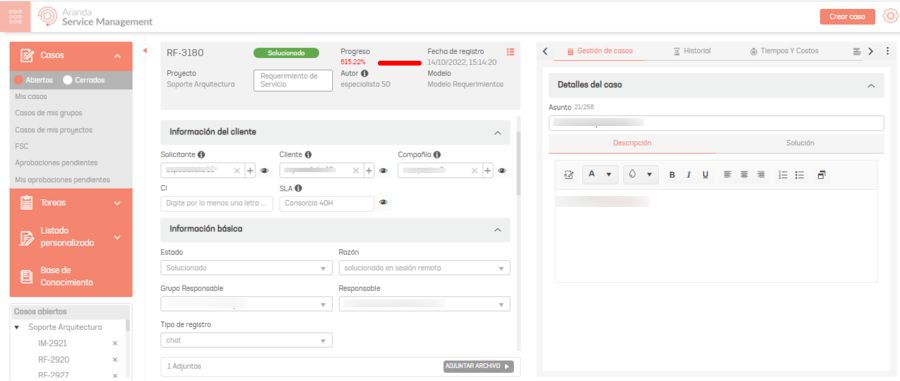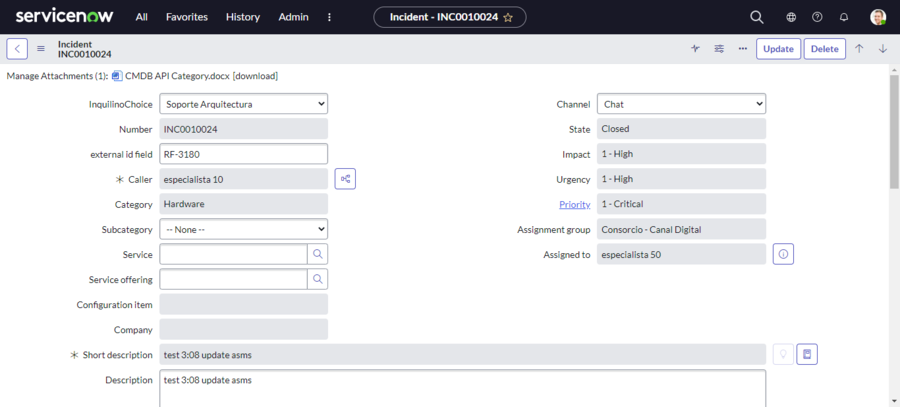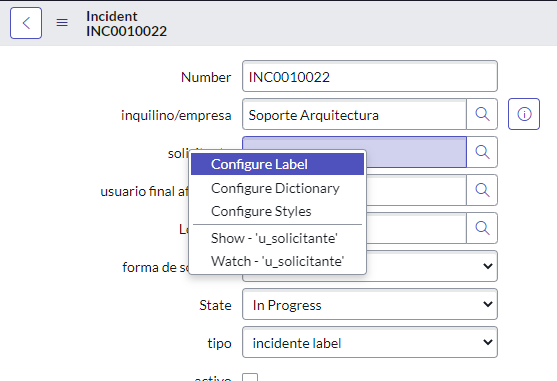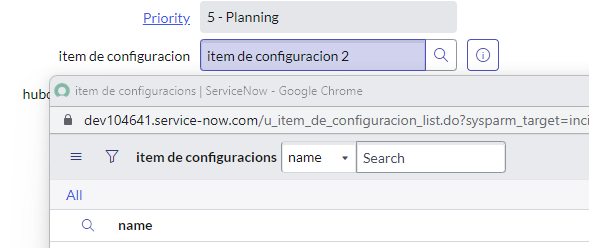The property “case” is a list that allows you to relate ASMS fields to ServiceNow fields:
Example of a case in ASMS

Ejemplo de un caso en ServiceNow

Los campos de casos en ASMS y ServiceNow se presenta mediante el siguiente JSON (Archivo de configuración):
{
"case": [
{
"table": "",
"externalIdField": "",
"definition": {
"itemType": "",
"typeRegister": {
"type": "",
"searchBy": "",
"key": ""
},
"service": {
"type": "",
"searchBy": "",
"key": ""
},
"project": {
"type": "",
"searchBy": "",
"key": ""
},
"category": {
"type": "",
"searchBy": "",
"key": ""
},
"applicant": {
"type": "",
"searchBy": "",
"key": ""
},
"responsibleGroup": {
"type": "",
"searchBy": "",
"key": ""
},
"responsible": {
"type": "",
"searchBy": "",
"key": ""
}
}
}
],
"urgency": [
],
"impact": [
],
"model": [
],
"typeRegister": [
],
"service": [
],
"project": [
],
"category": [
],
"applicant": [
],
"responsibleGroup": [
],
"responsible": [
]
}
1. Create a relationship between ServiceNow tables (incident, problem, change_request) with case types in ASMS:
| Types of cases in ASMS |
|---|
| Incidents, |
| Problem, |
| Change, |
| ServiceCall, |
| Release, |
| Table ServiceNow | ASMS Case Type |
|---|---|
| incident | Incidents |
| problem | Problem |
| change_request | Change |
2. On the property “table” in the configuration file type the name of the table incident:
{
"case": [
{
"table": "incident",
"externalIdField": "",
"definition": {
"itemType": "",
"typeRegister": {
},
"service": {
},
"project": {
},
"category": {
},
"applicant": {
},
"responsibleGroup": {
},
"responsible": {
}
}
}
]
}
3. On the property “definition.itemType” in the configuration file type type Incidents:
{
"case": [
{
"table": "incident",
"externalIdField": "",
"definition": {
"itemType": "Incidents",
"typeRegister": {
},
"service": {
},
"project": {
},
"category": {
},
"applicant": {
},
"responsibleGroup": {
},
"responsible": {
}
}
}
]
}
4. Get the name of the ServiceNow properties that you will relate to the ASMS properties by right-clicking on the field name and selecting the option show:

Ownership in ServiceNow
| Label | Name |
|---|---|
| RenterChoice | u_inquilinochoice |
| External ID Field | u_external_id_field |
| Category | category |
| Short description | short_description |
| Description | Description |
| Channel | contact_type |
| State | state |
| Impact | impact |
| Urgency | urgency |
| Assignment group | assignment_group |
| Assigned to | assigned_to |
5. Create a relationship between ASMS and ServiceNow properties:
| Property in ASMS | Ownership in ServiceNow |
|---|---|
| Project | u_inquilinochoice |
| idByProject | u_external_id_field * |
| category | category |
| subject | short_description * |
| Description | Description * |
| typeRegister | contact_type |
| state | state |
| impact | impact |
| urgency | urgency |
| responsibleGroup | assignment_group |
| responsible | assigned_to |
| service | N/A |
⚐ Note: Fields assigned with an asterisk ( * ) are assigned internally and cannot be modified.
6. Assign the type of mapping that the properties will perform:
| FieldValue: | It takes value directly from ServiceNow; if the field in ServiceNow is of type Reference you must add the value “searchBy” in the configuration file, this field corresponds to the field by which the value will be searched |
| Value: | Takes the value from the configuration file for the selected field |
| Mapper: | Assign this mapping value if you need to compare or relate ASMS and ServiceNow values |
| Property in ASMS | Ownership in ServiceNow | Mapping Type |
|---|---|---|
| Project | u_inquilinochoice | Mapper |
| category | category | Mapper |
| typeRegister | contact_type | Mapper |
| state | state | – |
| impact | impact | – |
| urgency | urgency | – |
| responsibleGroup | assignment_group | FieldValue |
| responsible | assigned_to | FieldValue |
| service | N/A | Value |
⚐ Note: Properties without any mapping will be covered in another section.
7. The properties assigned with the “mapping type” “FieldValue”, require ownership “searchBy” in the configuration file, this property allows you to search ServiceNow:

Give the lookup name for the properties type FieldValue:
| Property in ASMS | Ownership in ServiceNow | Mapping Type | Search field |
|---|---|---|---|
| Project | u_inquilinochoice | Mapper | – |
| category | category | Mapper | – |
| typeRegister | contact_type | Mapper | – |
| state | state | – | – |
| impact | impact | – | – |
| urgency | urgency | – | – |
| responsibleGroup | assignment_group | FieldValue | Name |
| responsible | assigned_to | FieldValue | Name |
| service | N/A | Value | – |
8. Type the relationship made in the previous steps in the configuration file:
{
"case": [
{
"table": "incident",
"externalIdField": "",
"definition": {
"itemType": "Incidents",
"service": {
"type": "Value"
},
"typeRegister": {
"type": "Mapper",
"key": "contact_type"
},
"project": {
"type": "Mapper",
"key": "u_inquilinochoice"
},
"category": {
"type": "Mapper",
"key": "category"
},
"responsibleGroup": {
"type": "FieldValue",
"searchBy": "name",
"key": "assignment_group"
},
"responsible": {
"type": "FieldValue",
"searchBy": "name",
"key": "assigned_to"
}
}
}
]
}
9. The property “externalIdField” is directly related to the property “idByProject”, for the example this property will take the value of the “external id field”: [u_external_id_field].
10. Type in the configuration file the name of the field to which you will relate the property “idByProject”:
{
"case": [
{
"table": "incident",
"externalIdField": "u_external_id_field",
"definition": {
"itemType": "Incidents",
"service": {
"type": "Value"
},
"typeRegister": {
"type": "Mapper",
"key": "contact_type"
},
"project": {
"type": "Mapper",
"key": "u_inquilinochoice"
},
"category": {
"type": "Mapper",
"key": "category"
},
"responsibleGroup": {
"type": "FieldValue",
"searchBy": "name",
"key": "assignment_group"
},
"responsible": {
"type": "FieldValue",
"searchBy": "name",
"key": "assigned_to"
}
}
}
]
}


